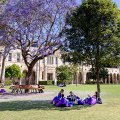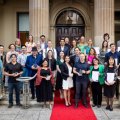Climate change, threats to our migratory shorebirds and polarisation - a type of light that humans cannot see - will be studied by University of Queensland researchers announced as prestigious Queensland-Smithsonian Fellows tonight.
The Queensland Government announced that UQ researchers Dr Martin How (Queensland Brain Institute), and Dr Ruth Reef and PhD student Nicholas Murray (both of UQ’s School of Biological Sciences) were awarded three of five 2012 Queensland-Smithsonian Fellowships.
UQ Vice-Chancellor Professor Peter Høj thanked the Queensland Government and the Smithsonian Institution for backing the scheme, and congratulated all the UQ fellows.
“Opportunities to gain global experience and connect with international peers will lay the groundwork for the success of research projects,” Professor Høj said.
“I urge all Queensland-Smithsonian Fellows to make the most of this prestigious award and advance the potential of their work to bring practical benefits to global society.”
The Smithsonian is the world's largest museum and research complex with 19 museums in Washington DC and New York City, the National Zoo, research centres in the United States, Panama and elsewhere, a network of 20 libraries and various education centres.
The Fellowships, valued at up to $30,000 each, were announced at the 2012 Science and Innovation reception, part of the bipartisan Science in Parliament program.
Fellowship support covers a return economy airfare for the Fellow and contributes towards the cost of living.
Winning UQ Queensland-Smithsonian Fellows and their projects are:
• Dr Martin How, who will study polarisation vision in fiddler crabs, said the visual world was full of polarised light produced by the reflection, refraction, scattering and filtering of sunlight.
“Without sunglasses, we cannot see polarised light, and so must rely solely on colour and brightness for vision,” he said.
Dr How said the crustacean visual system offered a different, and relatively understudied, perspective on the form and function of polarisation vision.
Using fiddler crabs as a model organism, the project will address fundamental questions, such as for what is polarisation vision used? How are eyes optimally tuned to detect polarised light? And can eyes adapt to new polarised light environments?
He said findings from this project could also lead to new biologically inspired technology in the field of digital imaging and optical filtering.
The project will be conducted at the Smithsonian Tropical Research Institute (STRI), Panama, under the guidance of senior staff scientist Dr John Christy, a world expert in fiddler crab behaviour.
• Dr Ruth Reef’s research will improve knowledge of how elevated carbon dioxide influences salinity tolerance in mangroves and other salt tolerant plants.
She said carbon dioxide fixation was at the heart of plant energy acquisition and global productivity.
“Atmospheric carbon dioxide concentrations are rising continuously and are expected to double by the end of the century,” she said.
“Given the strong dependence of plants on carbon dioxide, surprisingly little research is carried out on the impact of these changes on plants, especially wild plants.”
Dr Reef said carbon dioxide could affect salinity tolerance by altering water relations and by changing the energy allocated towards maintaining osmotic balance and plant growth under saline conditions.
• Nicholas Murray will draw on the expertise of research scientists at the Smithsonian’s Migratory Bird Centre to identify the international threats impacting Queensland’s migratory shorebirds.
The birds are threatened by a range of human activities in 23 countries during their yearly migration and they are now the most rapidly declining group of Australian birds.
“The causes of the declines are largely unknown and several recent analyses suggest that threats overseas may be the principal reason for the declines,” he said.
Through collaboration with Dr Peter Marra, a world-leading expert on migration biology, the project aims to develop wide-ranging conservation strategies to reduce declines of Queensland’s 36 species of migratory shorebird.
Media: Jan King 0413 601 248











